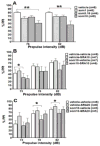Somatostatin-28 modulates prepulse inhibition of the acoustic startle response, reward processes and spontaneous locomotor activity in rats
- PMID: 20537385
- PMCID: PMC3215674
- DOI: 10.1016/j.npep.2010.04.008
Somatostatin-28 modulates prepulse inhibition of the acoustic startle response, reward processes and spontaneous locomotor activity in rats
Abstract
Somatostatins have been shown to be involved in the pathophysiology of motor and affective disorders, as well as psychiatric disorders, including schizophrenia. We hypothesized that in addition to motor function, somatostatin may be involved in somatosensory gating and reward processes that have been shown to be dysregulated in schizophrenia. Accordingly, we evaluated the effects of intracerebroventricular administration of somatostatin-28 on spontaneous locomotor and exploratory behavior measured in a behavioral pattern monitor, sensorimotor gating, prepulse inhibition (PPI) of the acoustic startle reflex, and brain reward function (measured in a discrete trial intracranial self-stimulation procedure) in rats. Somatostatin-28 decreased spontaneous locomotor activity during the first 10 min of a 60 min testing session with no apparent changes in the exploratory activity of rats. The highest somatostatin-28 dose (10 microg/5 microl/side) induced PPI deficits with no effect on the acoustic startle response or startle response habituation. The somatostatin-induced PPI deficit was partially reversed by administration of SRA-880, a selective somatostatin 1 (sst(1)) receptor antagonist. Somatostatin-28 also induced elevations in brain reward thresholds, reflecting an anhedonic-like state. The non-peptide sst(1) receptor antagonist SRA-880 had no effect on brain reward function under baseline conditions. Altogether these findings suggest that somatostatin-28 modulates PPI and brain reward function but does not have a robust effect on spontaneous exploratory activity. Thus, increases in somatostatin transmission may represent one of the neurochemical mechanisms underlying anhedonia, one of the negative symptoms of schizophrenia, and sensorimotor gating deficits associated with cognitive impairments in schizophrenia patients.
Published by Elsevier Ltd.
Conflict of interest statement
DH is a full-time employee of Novartis. MAG holds an equity interest in San Diego Instruments, Inc.
Figures

Similar articles
-
Interactions between corticotropin-releasing factor and the serotonin 1A receptor system on acoustic startle amplitude and prepulse inhibition of the startle response in two rat strains.Neuropharmacology. 2012 Jan;62(1):256-63. doi: 10.1016/j.neuropharm.2011.07.016. Epub 2011 Aug 2. Neuropharmacology. 2012. PMID: 21835187 Free PMC article.
-
Dorsal striatum D1-expressing neurons are involved with sensorimotor gating on prepulse inhibition test.J Psychopharmacol. 2017 Apr;31(4):505-513. doi: 10.1177/0269881116686879. Epub 2017 Jan 24. J Psychopharmacol. 2017. PMID: 28114835
-
Atypical antipsychotic olanzapine reversed deficit on prepulse inhibition of the acoustic startle reflex produced by microinjection of dizocilpine (MK-801) into the inferior colliculus in rats.Behav Brain Res. 2013 Nov 15;257:77-82. doi: 10.1016/j.bbr.2013.09.018. Epub 2013 Sep 14. Behav Brain Res. 2013. PMID: 24045065
-
Effect of gabapentin on sleep-deprivation-induced disruption of prepulse inhibition.Psychopharmacology (Berl). 2020 Oct;237(10):2993-3006. doi: 10.1007/s00213-020-05587-9. Epub 2020 Jun 27. Psychopharmacology (Berl). 2020. PMID: 32594186
-
Genetic models of sensorimotor gating: relevance to neuropsychiatric disorders.Curr Top Behav Neurosci. 2012;12:251-318. doi: 10.1007/7854_2011_195. Curr Top Behav Neurosci. 2012. PMID: 22367921 Free PMC article. Review.
Cited by
-
Sex-specific brain deficits in auditory processing in an animal model of cocaine-related schizophrenic disorders.Brain Sci. 2013 Apr 10;3(2):504-20. doi: 10.3390/brainsci3020504. Brain Sci. 2013. PMID: 24961412 Free PMC article.
-
Identification of neuropeptide receptors expressed by melanin-concentrating hormone neurons.J Comp Neurol. 2014 Dec 1;522(17):3817-33. doi: 10.1002/cne.23642. Epub 2014 Jul 17. J Comp Neurol. 2014. PMID: 24978951 Free PMC article.
-
Anxiolytic-like effects of somatostatin isoforms SST 14 and SST 28 in two animal models (Rattus norvegicus) after intra-amygdalar and intra-septal microinfusions.Psychopharmacology (Berl). 2011 Aug;216(4):557-67. doi: 10.1007/s00213-011-2248-x. Epub 2011 Mar 19. Psychopharmacology (Berl). 2011. PMID: 21424237
-
Centrally Administered Cortistation-14 Induces Antidepressant-Like Effects in Mice via Mediating Ghrelin and GABAA Receptor Signaling Pathway.Front Pharmacol. 2018 Jul 19;9:767. doi: 10.3389/fphar.2018.00767. eCollection 2018. Front Pharmacol. 2018. PMID: 30072893 Free PMC article.
-
Search strategy is regulated by somatostatin signaling and deep brain photoreceptors in zebrafish.BMC Biol. 2017 Jan 26;15(1):4. doi: 10.1186/s12915-016-0346-2. BMC Biol. 2017. PMID: 28122559 Free PMC article.
References
-
- Allen JP, Hathway GJ, Clarke NJ, Jowett MI, Topps S, Kendrick KM, Humphrey PP, Wilkinson LS, Emson PC. Somatostatin receptor 2 knockout/lacZ knockin mice show impaired motor coordination and reveal sites of somatostatin action within the striatum. Eur J Neurosci. 2003;17:1881–1895. - PubMed
-
- American Psychiatric Association. Diagnostic and Statistical Manual of Mental Disorders. 4. Washington, DC: American Psychiatric Press; 1994.
-
- Balazs M, Schwarzberg H, Telegdy G. Effects of somatostatin on self-stimulation behaviour in rats pretreated with a receptor blocker. Eur J Pharmacol. 1988;149:141–144. - PubMed
-
- Baldo BA, Jain K, Veraldi L, Koob GF, Markou A. A dopamine D1 agonist elevates self-stimulation thresholds: comparison to other dopamine-selective drugs. Pharmacol Biochem Behav. 1999;62:659–672. - PubMed
-
- Bassareo V, De Luca MA, Di Chiara G. Differential impact of pavlovian drug conditioned stimuli on in vivo dopamine transmission in the rat accumbens shell and core and in the prefrontal cortex. Psychopharmacology (Berl) 2007;191:689–703. - PubMed
Publication types
MeSH terms
Substances
Grants and funding
LinkOut - more resources
Full Text Sources

